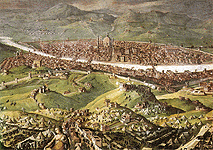
 |
| Florence |
Florence and Tuscany
Tuscany is located in the western part of the boot of Italy, north of Rome and south of Genoa. It is bounded by the Apennines to the North and East and by the Mediterranean on the West. Its land area is about 9,000 square miles. Its major cities are Florence, Pisa, Siena, Lucca, Arezzo, and Pistoia. Its major river is the Arno, on which Florence and Pisa are located.
It was the home land of the Etruscans, which was annexed by Rome in 351 BC. After the fall of the Roman empire, the region, which became known as Tuscany (Toscana in Italian) came under the rule of a succession of rulers (Herulians, Ostrogoths, etc.) and emerged as a political entity with its own rulers. By the twelfth century the Tuscan cities were gradually gaining their independence as republics and forcing the nobility to live in the cities. By the high Middle Ages the cities of Pisa, Siena, Arezzo, Pistoia, Lucca, and especially Florence had become wealthy because of textile manufacture, trade, banking, and agriculture. Gradually Florence came to overshadow and conquer all other cities in the region.
After several experiments with representative government, Florence was ruled by an oligarchy of wealthy aristocrats, among whom the Medici family became dominant in the fifteenth century. Under the patronage of these wealthy families the arts and literature flourished as nowhere else in Europe. Florence was the city of such writers as Dante, Petrarch, and Macchiavelli, and artists and engineers such as Boticelli, Brunelleschi (who built the magnificent dome on the church of St. Mary of the Flowers), Alberti, Leonardo Da Vinci, and Michelangelo. Because of its dominance in literature, the Florentine language became the literary language of the Italian region and is the language of Italy today. Lorenzo de' Medici, who ruled Florence in the late fifteenth century was perhaps the greatest patron of the arts in the history of the West.
But times changed. After Lorenzo the friar Savonarola ruled Florence, and the Medici were exiled. With the shift of commerce away from the Mediterranean and toward the Atlantic, after 1492, the economy of Tuscany went into a slow decline. In 1530 the Holy Roman Emperor Charles V conquered Florence and reestablished the Medici family in power. They were now dukes of Florence, and within a few decades Cosimo de Medici was made Grand Duke of Tuscany. Cosimo aggressively pursued a policy of economic revival, building the great harbor at Livorno because the harbor of Pisa had silted up.
Galileo was born under the rule of Cosimo in 1564. It was during this period that the Medici court increasingly firmly established its hold over the city. The court came to dominate all aspects of civic life, and for the Galilei family the route to success lay through the patronage structure in which the Court was central. In the seventeenth century Florence and Tuscany increasingly faded into obscurity and did not revive until the nineteenth century. It is today a major cultural center and attracts millions of tourists each year.
Last updated
Science | Christianity | Library | About | Site Map | Search
Please note: We will not answer copyright requests.
See the copyright page for more
information.










